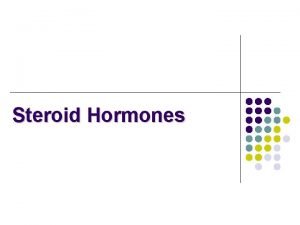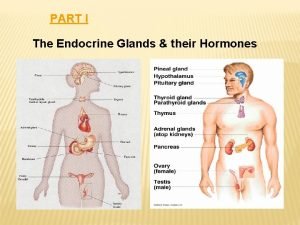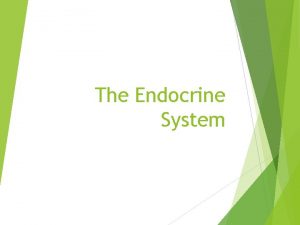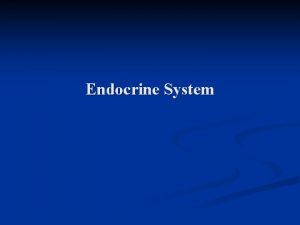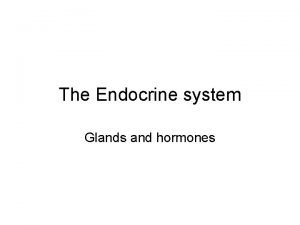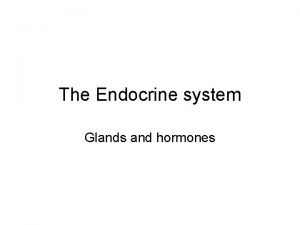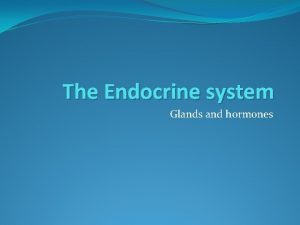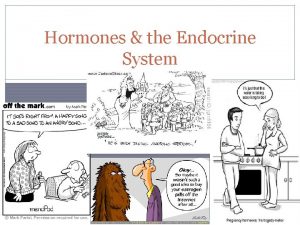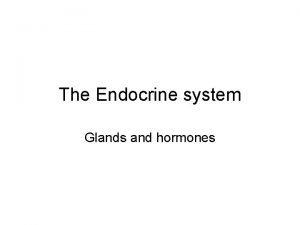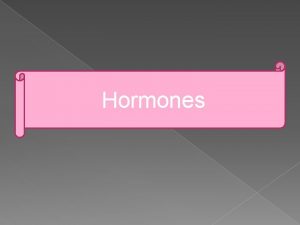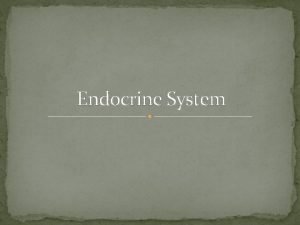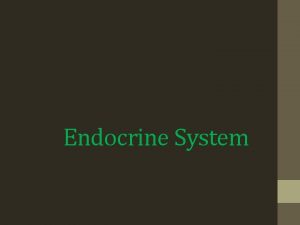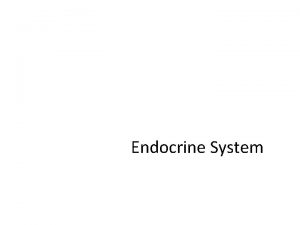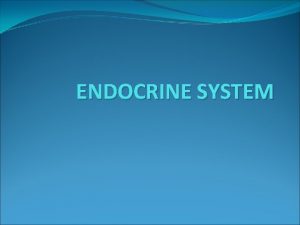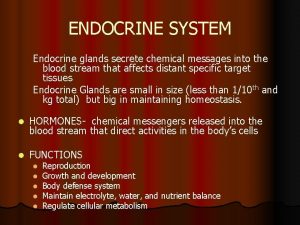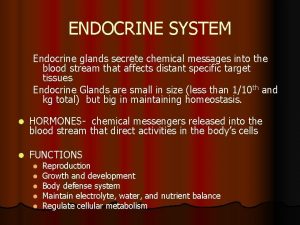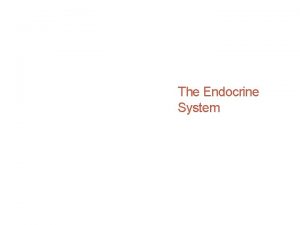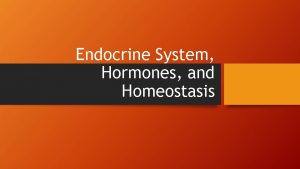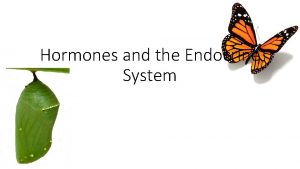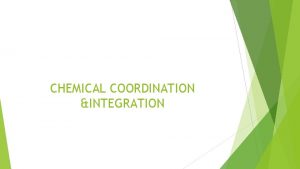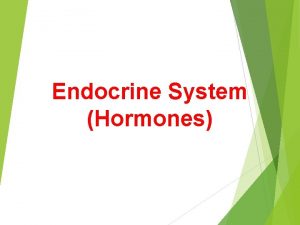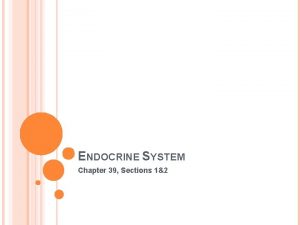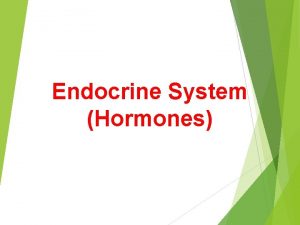The Endocrine System chemical messages hormones that are


























- Slides: 26

The Endocrine System § chemical messages (hormones) that are released into the blood § Hormones control several major processes § Reproduction - gametogenesis, sexual desire § Growth and development § Maintenance of homeostasis - salts, water, blood pressure, RBCs § Regulation of metabolism - digestion, stress responses Copyright © 2006 Pearson Education, Inc. , publishing as Benjamin Cummings

Endocrine System Characteristics § Access to every cell § Each hormone acts only on specific cells (target cells) that have matching receptors § Endocrine control slower than nervous system § Endocrine and nervous systems interact Copyright © 2006 Pearson Education, Inc. , publishing as Benjamin Cummings

Classification of Hormones: Steroid § Steroid Hormones: § Lipid soluble, derived from cholesterol § Enter target cells § Activate specific genes to produce proteins § Slower acting: minutes to hours Copyright © 2006 Pearson Education, Inc. , publishing as Benjamin Cummings

Steroid Hormones: How does a steroid hormone cause changes in cells? Copyright © 2006 Pearson Education, Inc. , publishing as Benjamin Cummings

Hormones: Nonsteroid § Amino acid-based hormones proteins, peptides, amines § Water soluble § Bind to receptors on target cell surface § Work via second messengers to activate existing enzymes § Faster action: seconds to minutes Copyright © 2006 Pearson Education, Inc. , publishing as Benjamin Cummings

Non-Steroid Hormones: How does a non-steroid hormone cause changes in cells? Copyright © 2006 Pearson Education, Inc. , publishing as Benjamin Cummings

Control of Hormone Release § Hormone levels are maintained by negative feedback § Low hormone levels or a stimulus triggers the release of more hormone § Hormone release stops once an appropriate level in the blood is reached Copyright © 2006 Pearson Education, Inc. , publishing as Benjamin Cummings

1. Hormonal Stimulus § Endocrine glands are activated by other hormones § Most common signalcoordinates response of several glands Figure 9. 2 a Copyright © 2006 Pearson Education, Inc. , publishing as Benjamin Cummings

2. Humoral Stimulus § Changing blood levels of certain ions stimulate hormone release § PTH - to raise Ca++ § Calcitonin - to decrease Ca++ § Insulin - to decrease glucose Figure 9. 2 b Copyright © 2006 Pearson Education, Inc. , publishing as Benjamin Cummings

3. Neural Stimulus § Nerve impulses stimulate hormone release § Usually by sympathetic nervous system Figure 9. 2 c Copyright © 2006 Pearson Education, Inc. , publishing as Benjamin Cummings

Location of Major Endocrine Organs Figure 9. 3 Copyright © 2006 Pearson Education, Inc. , publishing as Benjamin Cummings

Pituitary - Hypothalamus Relationship § Release of anterior pituitary hormones is controlled by hormones from hypothalamus § Hypothalamus produces two hormones that are stored in the posterior pituitary § posterior pituitary releases hormones when neurally stimulated by hypothalamus Copyright © 2006 Pearson Education, Inc. , publishing as Benjamin Cummings

Hormones of the Posterior Pituitary § Oxytocin § Stimulates contractions of the uterus during labor § Causes milk ejection § Antidiuretic hormone (ADH) § Can inhibit urine production § In large amounts, causes vasoconstriction Copyright © 2006 Pearson Education, Inc. , publishing as Benjamin Cummings

Hormones of the Anterior Pituitary §Six anterior pituitary hormones; common characteristics: §Proteins (or peptides) §Act through secondmessenger systems §Regulated by hormonal stimuli, mostly negative feedback Copyright © 2006 Pearson Education, Inc. , publishing as Benjamin Cummings

Growth Hormone (GH) § General metabolic hormone § Major effects are directed to growth of skeletal muscles and long bones § Causes amino acids to be built into proteins § Causes fats to be broken down for a source of energy Copyright © 2006 Pearson Education, Inc. , publishing as Benjamin Cummings

Functions of Other Anterior Pituitary Hormones § Prolactin (PRL) § Stimulates milk production following childbirth § Function in males is unknown § Adrenocorticotropic hormone (ACTH) § Regulates the adrenal cortex (affects salt, glucose levels) § Thyroid-stimulating hormone (TSH) § Influences thyroid gland Copyright © 2006 Pearson Education, Inc. , publishing as Benjamin Cummings

Functions of Other Anterior Pituitary Hormones § Gonadotropic hormones - appear at puberty § Follicle-stimulating hormone (FSH) § Stimulates follicle development (ovaries) and sperm development (testes) § Luteinizing hormone (LH) § Triggers ovulation § Stimulates testosterone production in males Copyright © 2006 Pearson Education, Inc. , publishing as Benjamin Cummings

Thyroid Gland § Found at the base of the throat § Produces two hormones § Thyroid hormone controls metabolism § Calcitonin - affects Ca++ levels in blood Copyright © 2006 Pearson Education, Inc. , publishing as Benjamin Cummings

Calcitonin § Decreases blood calcium levels by causing calcium deposition in bone (in children) § Antagonistic to PTH, parathyroid hormone Figure 9. 9 Copyright © 2006 Pearson Education, Inc. , publishing as Benjamin Cummings

Adrenal Glands § Two glands § Cortex – outer glandular region in three layers § Medulla – inner neural tissue region § Sits on top of the kidneys Copyright © 2006 Pearson Education, Inc. , publishing as Benjamin Cummings

Hormones of the Adrenal Cortex § Mineralocorticoids (mainly aldosterone) § Regulate mineral content in blood, water, and electrolyte balance via kidney action § Glucocorticoids (cortisone, cortisol) § Promote normal cell metabolism § Help resist long-term stressors § depress inflammatory response § Androgen, estrogen Copyright © 2006 Pearson Education, Inc. , publishing as Benjamin Cummings

Hormones of the Adrenal Medulla § Produces two similar hormones (catecholamines) § Epinephrine § Norepinephrine § prepare the body to deal with short-term stress Copyright © 2006 Pearson Education, Inc. , publishing as Benjamin Cummings

Roles of the Hypothalamus and Adrenal Glands in the Stress Response Figure 9. 12 Copyright © 2006 Pearson Education, Inc. , publishing as Benjamin Cummings

Pancreatic Islets §pancreas is a mixed gland §islet cells produce hormones: §Insulin – allows glucose to cross plasma membranes into cells §Glucagon – allows glucose to enter the blood §Somatostatin Figure 9. 13 Copyright © 2006 Pearson Education, Inc. , publishing as Benjamin Cummings

Diabetes § Diabetes mellitus - “sweet siphon” § Type I - lack of insulin § juvenile § Type II - resistant to effects of insulin § Adult onset Copyright © 2006 Pearson Education, Inc. , publishing as Benjamin Cummings

Other Hormone Sources § Thymus: thymosin and thymopoietin, assist maturation of T lymphocytes § Pineal gland: melatonin § Heart: atrial natriuretic hormone (ANH) § Digestive system: gastrin, secretin, cholecystokinin § Kidney: erythropoietin, renin Copyright © 2006 Pearson Education, Inc. , publishing as Benjamin Cummings
 Oxication
Oxication Hormones
Hormones Insidan region jh
Insidan region jh Endocrine system and reproductive system
Endocrine system and reproductive system Endocrine system vs nervous system
Endocrine system vs nervous system Lymphatic system vs endocrine system
Lymphatic system vs endocrine system Amino acid-based hormones
Amino acid-based hormones Endocrine system
Endocrine system What is the chemical classification of this hormone?
What is the chemical classification of this hormone? Ngoại tâm thu thất chùm đôi
Ngoại tâm thu thất chùm đôi Block nhĩ thất độ 2 type 1
Block nhĩ thất độ 2 type 1 Thể thơ truyền thống
Thể thơ truyền thống Thơ thất ngôn tứ tuyệt đường luật
Thơ thất ngôn tứ tuyệt đường luật Walmart thất bại ở nhật
Walmart thất bại ở nhật Tìm vết của đường thẳng
Tìm vết của đường thẳng Con hãy đưa tay khi thấy người vấp ngã
Con hãy đưa tay khi thấy người vấp ngã Tôn thất thuyết là ai
Tôn thất thuyết là ai Gây tê cơ vuông thắt lưng
Gây tê cơ vuông thắt lưng Sau thất bại ở hồ điển triệt
Sau thất bại ở hồ điển triệt Endocrine
Endocrine Adenohypophysis
Adenohypophysis The body's speedy electrochemical communication network
The body's speedy electrochemical communication network Comparison of endocrine and nervous system
Comparison of endocrine and nervous system Steroids endocrine system
Steroids endocrine system Facts about the endocrine system
Facts about the endocrine system Diaphragm of rat
Diaphragm of rat Endocrine system pearson
Endocrine system pearson








